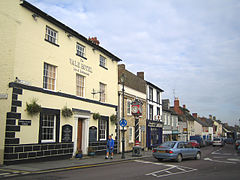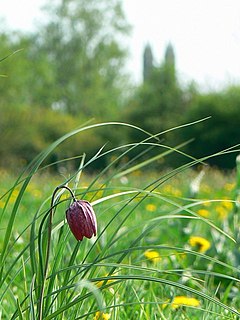Cricklade
| Cricklade | |
|---|---|
 Jubilee Clock and part of the High Street |
|
 Snake's head fritillaries in the National Nature Reserve, with the Anglican church behind |
|
| Cricklade shown within Wiltshire | |
| Population | 4,227 (in 2011) |
| OS grid reference | SU101936 |
| Civil parish |
|
| Unitary authority | |
| Ceremonial county | |
| Region | |
| Country | England |
| Sovereign state | United Kingdom |
| Post town | Swindon |
| Postcode district | SN6 6 |
| Dialling code | 01793 |
| Police | Wiltshire |
| Fire | Dorset and Wiltshire |
| Ambulance | South Western |
| EU Parliament | South West England |
| UK Parliament | |
| Website | Town Council |
Cricklade is a small town and civil parish on the River Thames in north Wiltshire, England, midway between Swindon and Cirencester. The parish population at the 2011 census was 4,227.
Cricklade's Latin motto is In Loco Delicioso, which means "in a pleasant place".
In 2011, Cricklade was awarded the Royal Horticultural Society's 'Champion of Champions' award in the Britain in Bloom competition. The small town has many sporting events and hosts the annual Cricklade Show. Cricklade has a large Jubilee clock, erected in 1898 in honour of Queen Victoria's Diamond Jubilee the preceding year. The clock stands outside the Vale Hotel in High Street, where the Town Cross once stood; there are two versions of the cross in Cricklade, one in the churchyard of St Sampson's, the other at St Mary's, and there is local rivalry as to which one is believed to be the older.
Cricklade was founded in the 9th century by the Anglo-Saxons, at the point where the Roman road Ermin Way crossed the River Thames. It was the home of a royal mint from 979 to 1100; there are some Cricklade coins in the town museum. The Domesday book records Cricklade as the meeting place of Cricklade hundred in 1086.
It is one of thirty burhs (fortresses or fortified towns) recorded in the Burghal Hidage document, which describes a system of fortresses and fortified towns built around Wessex by King Alfred. Recent research has suggested that these burhs were built in the short period 878–79 both to defend Wessex against the Vikings under Guthrum, and to act as an offensive to the Viking presence in Mercia. It is argued that the completion of this system, of which Cricklade – situated only a little way down Ermin Street from Cirencester, the Viking base for a year – was a key element, precipitated the retreat of the Vikings from Mercia and London to East Anglia, according to the Anglo-Saxon Chronicle in late 879.
...
Wikipedia

